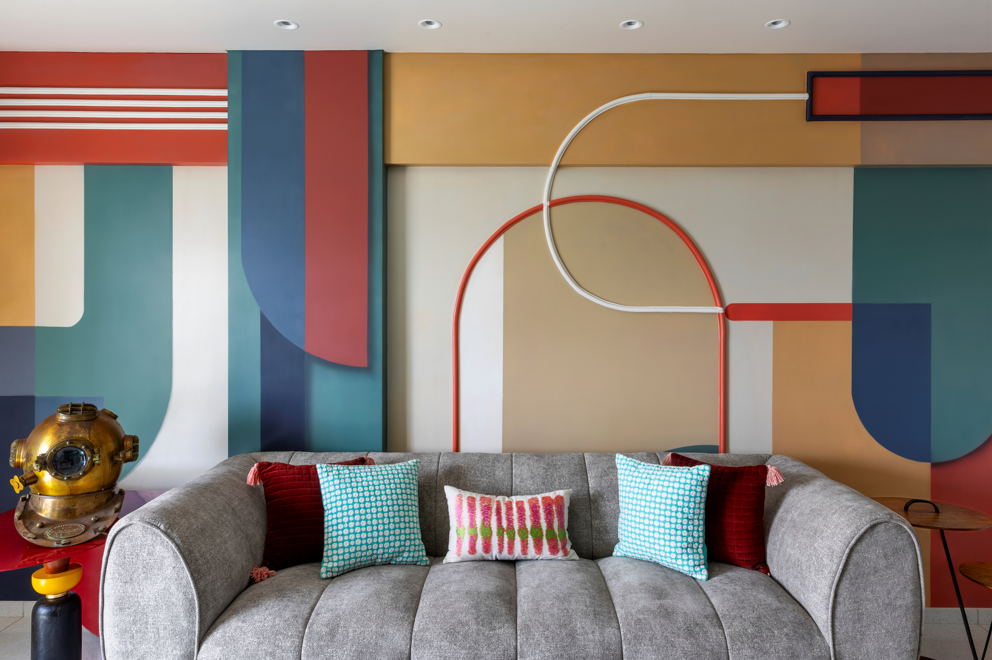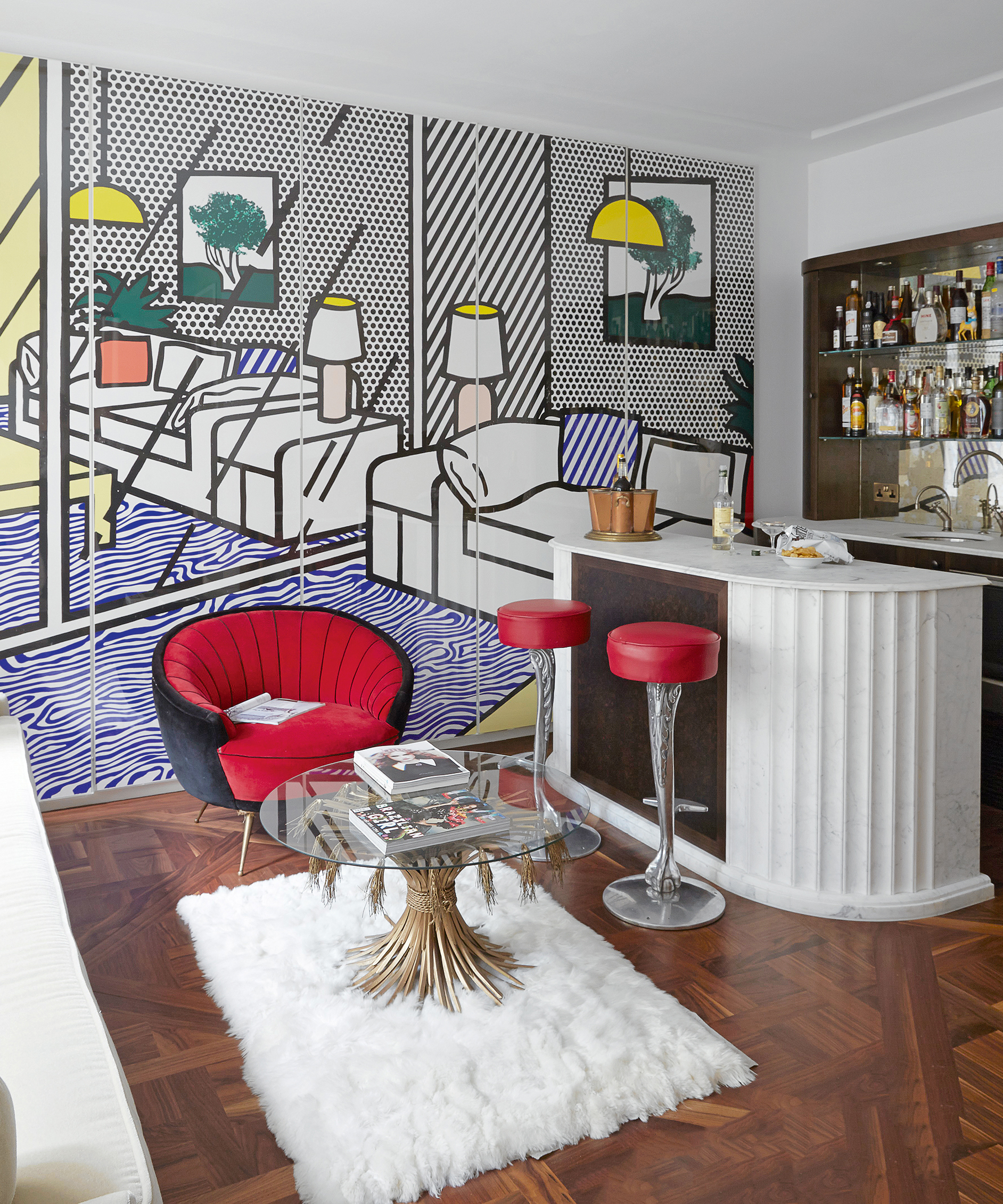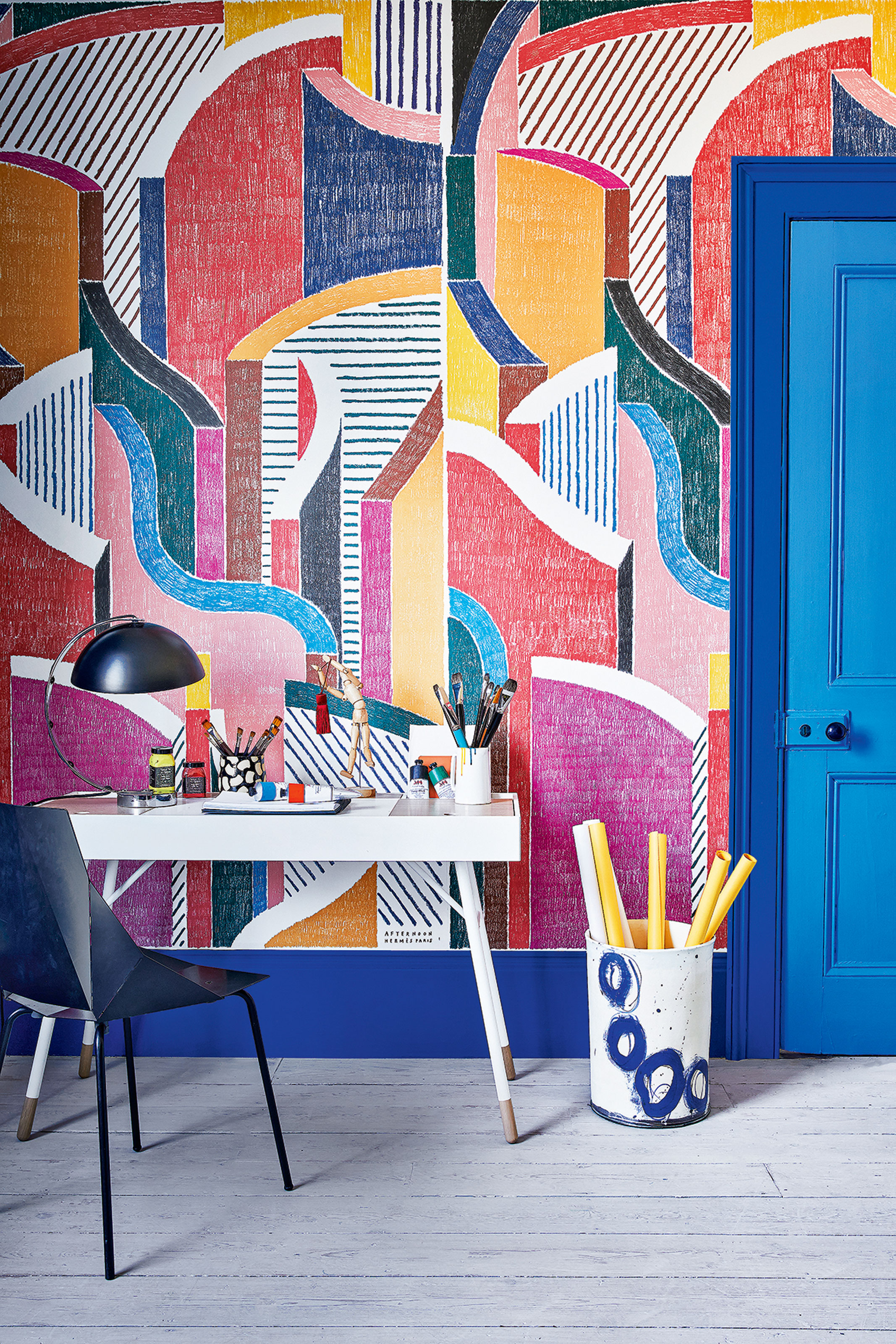Wall mural ideas – 12 ways to make a big impact with paint, wallpaper and more
Experiment with these wall mural ideas and create incredible, inspiring interiors for your home


Choosing a wall mural idea for your home might seem bold, but if you strike the right balance, you can make magic happen. If you decide on these larger-than-life designs to make a superlative statement in your scheme, you can leave the rest of the space pared down and clean. With a mural, your walls can do all the talking.
Wall murals usually stretch across single walls, but they can also be used to envelop a room. And there is an incredible variety of styles. From small to large motifs, bold and graphic to minimalist and soft, there's a mural design to suit any type of home.
They work across different mediums too. Some of the best wall murals are paint ideas, created by artists or skilled decorators, while others use special wallpaper panels, put up to create the mural effect.
Before jumping on this trend bandwagon, think about your mural carefully – after all, its presence will be looming in your home. Perhaps choose soothing colors that you know you can live with for a long time, or keep your mural design to one feature wall.
Whatever your approach, there's a mural design to suit it. We've rounded up 10 ideas for wall murals to consider to make a statement in your home.
12 wall mural ideas to suit every design scheme

'Murals can act as a focal point for celebrating and reflecting your personality,' says Anupriya Sahu, founder and design head, Alankaram. 'There are many ways to experiment with murals to enhance any space. For instance, opting for a mural with a layered design and assorted pattern is a great way to add color, depth, and texture to a space. To make a prominent statement, one can have a large-scale design on walls,'
'These murals also can be in the form of blousy florals, a landscape, an architectural wonder, or even abstract patterns,' Anupriya suggests. 'Such designs can be incorporated through paint, wallpaper or tiles, or even with experimentation in materials like wood, cement, brick, artboard, canvas, and clay. Once finished, the design makes for somewhere that an onlooker can gaze on for hours. Ultimately, they become a source of tranquillity and charge the spaces with emotion.'
The Livingetc newsletters are your inside source for what’s shaping interiors now - and what’s next. Discover trend forecasts, smart style ideas, and curated shopping inspiration that brings design to life. Subscribe today and stay ahead of the curve.
1. Get creative with paint for a simple mural

Armed with the right wall mural ideas and some basic painting skills, anyone can turn their hand to designing their own mural. Remember, quality acrylic mural paints are the ideal choice. Choose paint with a matte or eggshell finish so that light doesn't reflect off the mural. If you aren't a complete pro, stenciling is a great mural technique because you can simply buy a readymade design and transfer it on the wall, and paint over it.
Colors are a delicious way to bring in captivating visuals in a room. In this image, the three-tone wall shows a wonderful color layering effect, with completing shades taking over the wall. The rest of the interior is muted and the result is a bold and dramatic look.
‘Exploring different paint finishes in the same hue with color drenching and monochromatic schemes add interest whilst remaining restful and uncluttered,' suggests says John Ashton of paint brand Albany. 'Wall murals, textures, and color blocking in harmonious tones help add character, color, and a sense of cohesion to open-plan spaces.’
2. Bring in texture and depth with wall murals

Using a mural to add texture and depth is also a great way to give the space a one-of-a-kind look. A wide variety of paints and even wallpaper ideas can do the deed. Some can even help you create an eye-catching Trompe-l'œil that makes your space feel bigger – using shadows, proportion and scale to create a mural that feels three-dimensional.
Textured paints and wallpapers bring some weight to your scheme and prevent a room from looking nondescript, even if it's a minimalist style. It helps living spaces capture attention. To give the room a level of sophistication, carefully choose textures that will complement each other and other elements in the room for a unified look.
3. Commission a bespoke painted mural

Wall murals add color and life to any space, and they can be a fun alternative to larger pieces of art. These can also be immensely satisfying projects for commissioned artists who love working on a grand scale.
While you don't need to be a complete pro to have a go at painting a mural, if you’ve never picked up a paintbrush before, then start on a smaller canvas and work your way to your large, indoor wall – the perfect weekend project for those with the right skillset.
'Painted murals are more like commissioned artworks that are curated, based on the owner’s personality and background,' says Meena Murthy Kakkar, design head and partner, Envisage. 'Even if you're choosing something like a realistic landscape, you can opt to have it hand-painted directly on walls instead of using wallpaper.'
In this space, a heritage-inspired design plays well against the decorative moldings and finishes, and has the feeling that it could have been an original feature of this home.
4. Create an illusion with a mural wallpaper

Large murals are eye-catching, to say the least, and when you choose a design with depth of color and intricate detailing, like this dining room wall idea, you can feel like you're almost inside the mural. However, by choosing a print that is so captivating, it can become challenging to design the rest of the space.
Let the palette of the mural dictate the other colors around the room. Pick one color present in your mural design and sprinkle it across your scheme – on furniture, curios, and other elements. Then, choose one main neutral to ground the palette.
In this space, the black dining table and chairs help foreground the huge wall art. The small tabletop elements carry through the green tones, connecting the décor with the mural. The painting helps create an indoor-outdoor feel as if the dwellers are dining in the wilderness outside.
5. Incorporate mural design on the ceiling

Murals don't have to end at just the walls – take them up to the ceiling, covering panels and skirting, creating an impact on the entire space. Taking the mural to the ceiling is a fantastic way to play with perspective. It can make a space feel larger as you eliminate the visual barriers between the wall and ceiling, and extend the dimensions of your space.
It also makes a brilliant feature for those more compact areas of your home, like this small bathroom idea. Creating a bold design in a smaller space means it won't overwhelm your entire home, but can be an interesting surprise, especially when used somewhere like a guest bathroom.
If you're planning on painting the wall and ceiling mural, you will need to keep a few points in mind. Painting the ceiling can be tricky but if you prep for it well, the process can be a breeze. Be sure to move all your furniture out of the space, protecting it from paint drips. But if moving furniture isn't possible, make sure you cover it with dust sheets. Also, lay out a floor protector to avoid getting paint on the floorboard and carpet. Don't forget to start your mural from the top down too.
6. Consider peel-and-stick wall murals

No nails, no paint, no wallpaper, no commitment – wall decals are the perfect idea for when you don't want anything too permanent on your walls. These work particularly well in spaces that are subject to constant change – a kids' room for instance.
Bespoke wall decals can be cut-to-size and shape and applied by anyone. These can be removed at any point, without damaging the walls, and give the same, fabulous effect as wall murals.
While designing children's bedrooms, also keep in mind the colors you're planning on using. It's suggested that green paint, for example, can help improve a child's reading speed and comprehension, while also helping them relax. 'When chosen in a suitable shade, green can add comfort to a space and be paired with indoor plants to achieve a connected interior scheme,' says Rahul Mistri, principal designer at Open Atelier.
7. Design a mural wall with mosaic tiles

Wallpaper and paints aside, tiles too can create a bold and exciting mural for a bathroom or kitchen – something that draws the eye as soon as you step in.
Of course, tiles are much more permanent than paintings so you want to be sure before you create a statement wall in these spaces. If you want to create a bright interior, choose primary shades or high contrast color tiles. If a more neutral design is your choice then pale natural shades like beige, white, brown, or grey would be best.
Mosaics aren't the only type of mural that work for bathroom wall ideas, however. You can also find mural designs that create a waterproof barrier for walls and can even be used in shower enclosures.
8. Design a three-dimensional wall mural with mix materials

Murals tend to be defined as designs that play out over an entire wall, rather than in small repeats of pattern. So why not consider your wall decor as part of it? Who said you need to choose one medium for a wall mural idea, after all.
In decorating this apartment, a simple graphic wall mural has been embellished by hanging a Studio Pepe rug from CC-Tapis on the wall. This wall hanging echoes the design of the mural, and is decorative and colorful, so it easily stands in as part of the painting.
It's a perfect marriage of materiality, color, and structure. The rug melds into the wall paint, and as its color flows to the rest of the wall, an eye-catching interior emerges.
9. Experiment with graphic mural art

In recent times, graphic art has taken over almost every surface, be it cushion covers, bedspreads, artworks to even wall murals. These computer-generated illustrations, in large prints and proportions, inject a fun, modern, and youthful vibe, ideal for those looking to add maximalism to their interior design. It's easy to customize a design that suits not only the room's dimensions but your personality too.
In this image, the entire wall has been used as a canvas for art, making the bar area into a fun, upbeat space. This Pop Art-inspired mural also gives an illusion of extended space, and injects color into what is otherwise a simple white room.
10. Introduce geometric patterns

'Geometric patterns in various colors, proportions, and designs can bring dramatic vibrancy to your interiors,' explains Rahul Mistri. Bold colors mixed with abstract forms help charge even the most traditional rooms with curious contradiction. These types of patterns can create a big impression in the room, and give the space a modern, rebellious edge.
For an up-to-date take on geometrics patterns, follow the interior design trend for organic shapes and choose a design that incorporates rounded, curved elements as well as angular ones, as in this colorful mural design.
11. Create an abstract mural wall

A mural doesn't always have to be a large, wall-to-wall design that dominates the entire space. Mural can also work in simple, pared-down interiors, adding a decorative touch to the room. Take this minimalist bedroom designed by MangeshDL for instance. The abstract wall mural lends character to the otherwise neutral space without being overwhelming.
The beauty of abstract art is that it has no singular style or boundaries, and so it effortlessly lends a creative look to any space. Abstract shapes also fuel imagination, making them the perfect choice for little children's bedrooms. You could create your stencils and make the mural painting, a shared activity with children.
12. Try spray painting mural art

Spray-painted walls have edge and punk energy, and if this look appeals to you, then consider bringing in this wall mural idea at home.
Ideally, the right time to spray paint a mural is when the home is in the early phases of building or remodeling. You can spray the walls without worrying too much, and if it all goes wrong, you can simply whitewash it and start afresh. This could be a great living room DIY project for the right design, or could be used in areas for an inindoor-outdooreel, especially on internal brick walls.
The advantage of paint sprayers is that they can easily get to crown moldings, popcorn ceilings, cornices, and masonry. These can reach the narrowest crevices, and establish dominance. It is a lot faster than brush or rollers. If you plan on renting a sprayer, choose an airless one for one-time use.
Keep in mind, however, that sprays consume paint very fast, and so it may turn out to be a slightly more expensive project. Ideally, choose this if you want to get one statement wall, but if it's an entire room (plus ceiling), traditional paint may be a more budget-friendly choice.
How do I paint a wall mural?
If you fancy yourself as an artist, love DIY projects, and don't mind getting your hands dirty, then you could try your hand at painting your own wall mural. You could try painting blocks of color to create a design, use stencils or even try a freehand design. There's no better way to add a personal touch to your walls than with murals.
If you're painting your mural, apply the base color the night before so it dries in time before you start the big job. For simple nature-inspired designs like trees and clouds (ideal for children's bedrooms), there are plenty of designs that can be created freehand or with a stencil.
To paint a wall mural the right way, remember, the right shade and proper tools are key. Arrange a step ladder, a roller, a 2-inch brush, dust sheets, and a roller tray. Wipe down the walls and use masking tape to protect corners or skirting that you don't want to get paint on. Choose a watered-down emulsion if you're painting on fresh plaster or going from a light color to dark. Two coats should do the job.
Create a grid using horizontal and vertical lines. Divide the artwork into the columns and rows which gives you 100 unique boxes. Copy the artwork on each box on the wall. Once all the boxes are done, you’ll be able to see the entire mural come to life.
Remember, if you're painting a wood-clad wall, you'll need a different paint. You can ask the local retailer for suggestions, but eggshell should be fine. Let it dry for two days and watch how the color of the wall changes as the lights change in the room. If you want a darker tone, apply another coat of paint.

Aditi Sharma Maheshwari started her career at The Address (The Times of India), a tabloid on interiors and art. She wrote profiles of Indian artists, designers, and architects, and covered inspiring houses and commercial properties. After four years, she moved to ELLE DECOR as a senior features writer, where she contributed to the magazine and website, and also worked alongside the events team on India Design ID — the brand’s 10-day, annual design show. She wrote across topics: from designer interviews, and house tours, to new product launches, shopping pages, and reviews. After three years, she was hired as the senior editor at Houzz. The website content focused on practical advice on decorating the home and making design feel more approachable. She created fresh series on budget buys, design hacks, and DIYs, all backed with expert advice. Equipped with sizable knowledge of the industry and with a good network, she moved to Architectural Digest (Conde Nast) as the digital editor. The publication's focus was on high-end design, and her content highlighted A-listers, starchitects, and high-concept products, all customized for an audience that loves and invests in luxury. After a two-year stint, she moved to the UK and was hired at Livingetc as a design editor. She now freelances for a variety of interiors publications.